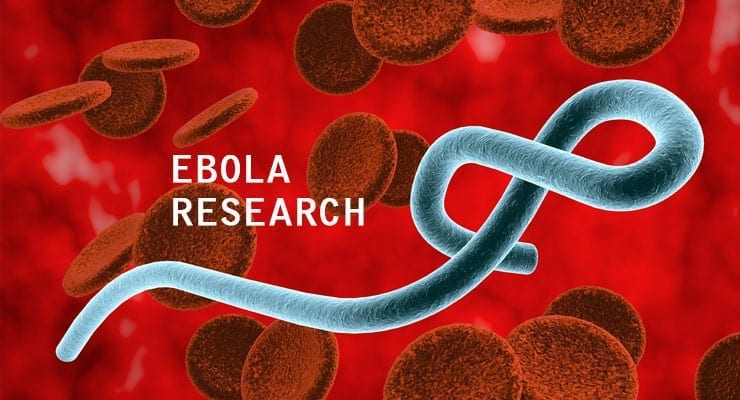Researchers at the U.S. Army Medical Research Institute of Infectious Diseases (USAMRIID) have demonstrated that their novel small-molecule antiviral drug completely protected rhesus monkeys from Ebola virus when treated three days after infection.
The compound, known as GS-5734, blocks the virus’s ability to replicate its own genetic material, prohibiting it from making copies of itself.
The research findings were published last week in the journal Nature.
USAMRIID, Gilead Sciences, CDC Collaboration
Travis Warren, Ph.D., a principal investigator at the U.S. Army Medical Research Institute of Infectious Diseases (USAMRIID) and first author of the paper, said the work is the result of continuing collaborations between USAMRIID and Gilead Sciences of Foster City, Calif.
Scientists at the Centers for Disease Control and Prevention (CDC) also contributed by performing initial screening of the Gilead Sciences compound library to find molecules with promising antiviral activity.
That initial work identified the precursor to GS-5734, a small-molecule antiviral agent, which led to the effort by Gilead and USAMRIID to further refine, develop and profile the compound. Led by USAMRIID Science Director Sina Bavari, Ph.D., the paper’s senior author, the research team used cell culture and animal models to demonstrate the compound’s antiviral activity against several pathogens, including Ebola virus.
See also: Rapid Medical Countermeasure Response to Infectious Diseases
In animal studies, treatment initiated on day 3 post-infection with Ebola virus resulted in 100 percent survival of the monkeys. The animals also exhibited a substantial reduction in viral load and a marked decrease in the physical signs of disease.
In cell culture studies, led at USAMRIID by Veronica Soloveva, Ph.D., GS-5734 was active against a broad spectrum of viral pathogens. These included Middle East Respiratory Syndrome (MERS) virus, Marburg virus, and multiple variants of Ebola virus, including the Makona strain causing the most recent outbreak in Western Africa.
“GS-5734 has several favorable characteristics for potential treatment of Ebola virus disease in humans. It is made using well-controlled chemical synthesis procedures, is stable, and can be made on a large scale,” Bavari commented. “It shows substantive post-exposure protection against Ebola virus in nonhuman primates, even when treatments were started after virus had spread to the blood in some animals.”
In addition, the researchers saw no evidence from genetic sequence analyses that the Ebola virus was able to generate resistance to GS-5734.
A Push for Further Development
Taken together, the robust therapeutic efficacy observed in primates, the favorable drug-like properties, and the potential for broad-spectrum antiviral activity suggest that further development of GS-5734 for the treatment of Ebola virus and other viral infections is warranted, Bavari said.
According to Tomas Cihlar, Ph.D., of Gilead Sciences, the company is currently conducting a series of phase I clinical studies in healthy human volunteers to establish the safety and pharmacokinetic profile of GS-5734.
See also: ZMapp Trial Shows Signs of Efficacy, But Data Insufficient
The compound also has been provided for compassionate use to treat two patients with Ebola virus infection, both of whom were discharged from the hospital. One of them was the Scottish nurse with recrudescent disease and the other was an acutely infected newborn, thus far the last identified case of Ebola virus infection in Guinea.
“With the hope that the West African outbreak will remain under control, we are exploring alternative options for the development path of GS-5734, including potential use of the animal efficacy rule,” Cihlar said. The animal rule is a regulatory mechanism under which the U.S. Food and Drug Administration may consider efficacy findings from adequate and well-controlled animal studies of a drug in cases where it is not feasible or ethical to conduct human trials.
Research on Ebola virus is conducted in Biosafety Level 4 (maximum containment) laboratories, where investigators wear positive-pressure “space suits” and breathe filtered air as they work. USAMRIID is the only organization in the Department of Defense with Biosafety Level 4 capabilities, and its research benefits both military personnel and civilians.
Read more at Nature: Therapeutic efficacy of the small molecule GS-5734 against Ebola virus in rhesus monkeys.


